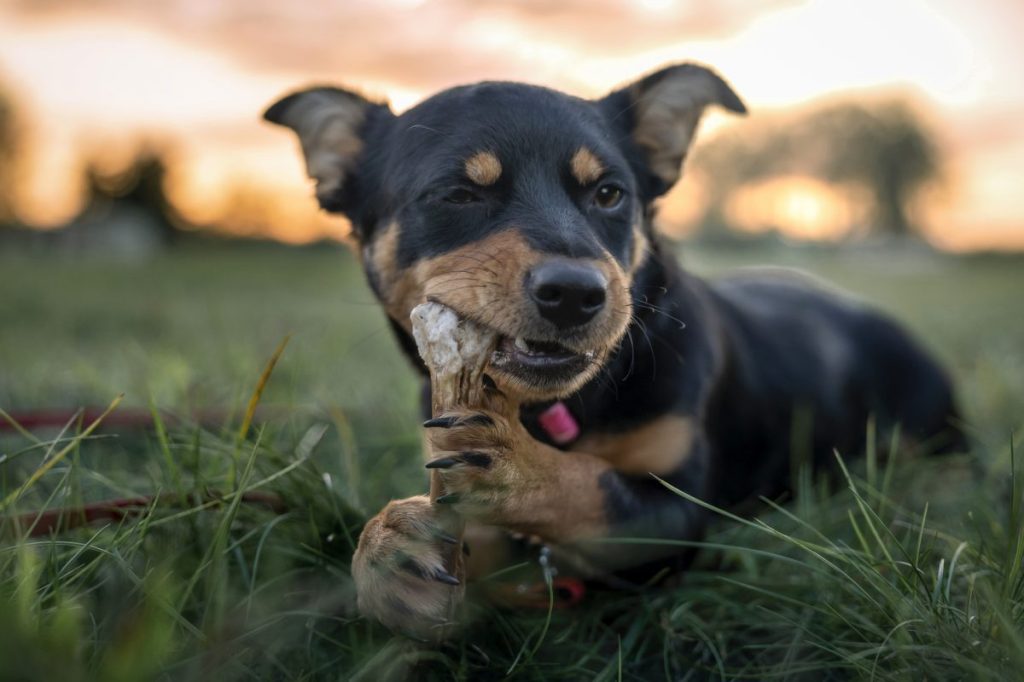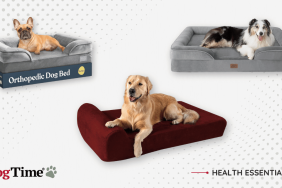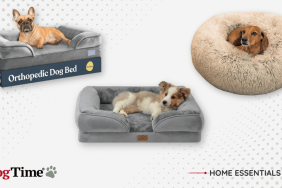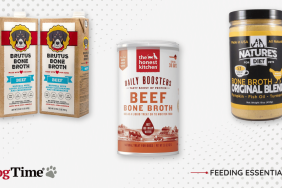With all the contradictory information out there about feeding bones to dogs, it’s important to truly know which dog bones are safe. Giving your dog one can be very dangerous, or, if you’re well-informed and follow some simple rules, it can be safe and even good for your pup.
That said, you should always discuss with your vet before giving your pup new foods, bones, or chews to make sure you’re being as safe as possible. Here’s what to know.
Should dogs eat cooked bones?
Cooked bones, including those that come from table scraps like chicken wings or pork ribs, are not safe for your dog to eat. They can easily break and splinter, which can cause serious health problems.
Eating cooked bones can lead to:
- Broken teeth
- Mouth or tongue injuries
- Bones looped around the lower jaw
- Windpipe, esophagus, or gastrointestinal blockage
- Constipation
- Rectal bleeding
- Peritonitis
Are store-bought bones safe for dogs?
Additionally, the FDA warns that commercially available bone treats, which are often processed and differ from those you might receive from a butcher, may present similar dangers and cause illnesses in dogs.
In 2015, the FDA received 35 reports of dogs suffering from a variety of conditions related to commercially available bone treatment products including ham bones, pork femur bones, rib bones, and smokey knuckle bones. Companies often dry these products through smoking or baking and add preservatives, seasoning, or smoke flavoring.
The dogs in the reports suffered from the following:
- Gastrointestinal blockage
- Choking
- Cuts in the mouth or on the tonsils
- Vomiting
- Diarrhea
- Rectal bleeding
- Death (in the case of eight of the dogs)
If you are considering store-bought chews or bones for your dog, it’s best to consult your vet to make sure you’re getting appropriate products for your individual pet.
Are rawhides safe for dogs?
Rawhide chews sometimes cause similar conditions as store-bought bone treats. Made from the inner layer of cow or horse hides, the manufacturing process of these chews can leave them with trace amounts of toxic chemicals. Furthermore, they also have the potential for contamination with Salmonella or E. coli.
Rawhides can cause digestion problems, as well as blockages. Always monitor your dog if you give them a rawhide. Some rawhide chews can contain other additives and preservatives that may be toxic or cancer-causing. Avoid chews with these ingredients.
Are bully sticks safe for dogs?
Compared to rawhides, bully sticks are more easily digestible and carry a lower risk of choking. However, they’re not meant to be eaten quickly and can still pose a hazard — especially for aggressive chewers.
If you choose to give your dog a bully stick, be sure to supervise their chewing. It’s also important to note that, like other animal-based treats, bully sticks can carry a risk of bacterial contamination.
What bones are safe for dogs?
Most raw bones that have not been cooked are edible for dogs. However, vets still caution against raw chicken bones due to the risk of splintering. Raw lamb or beef bones are soft enough to chew, eat, and digest.
That said, with all bones, there is a risk of choking if your dog swallows without thoroughly chewing, and bones that are too hard can cause damage to the teeth. Some vets caution against giving your dog bones at all due to the risks.
Recreational bones are not designed to be edible, but rather chewed by dogs. These can include large femur or hip bones from bison or beef and are filled with marrow. These bones may have meat, cartilage, or soft tissue still attached. You can usually find these at your local butcher.
With raw bones and meat, there is still some risk of bacterial contamination. You can reduce these risks with proper handling. Ask your vet for suggestions about the best way to safely handle and store raw bones.
Dog bone safety guidelines
If you’d like to give your dog a bone to eat or chew, follow these rules so they enjoy their bone safely.
- Supervise chewing. Never leave your dog to chew a bone alone. They may bite off too much and choke or gnaw too aggressively and cause injury.
- Throw out gnawed-down bones. If your dog chews a bone down to the brittle part, splintering becomes a problem. Additionally, a bone that has been chewed down too small becomes a choking hazard.
- Do not give bones to a dog who has had restorative dental work. These dogs are at risk for tooth breakage and dental problems.
- Do not give a bone to a dog who’s likely to bite it in half and swallow large chunks. You know how your dog eats. If your dog swallows food quickly rather than chewing, a bone presents a risk.
- Don’t feed your dog bones that can be swallowed whole. This depends on the size of your dog. A small bone is not safe for a Great Dane, for instance.
- Don’t feed your dog a bone cut lengthwise. A cut leg bone, for example, is more likely to splinter.
- Don’t feed your pup pork or rib bones. These bones are more likely to splinter.
- Only let your dog chew for ten to 15 minutes at a time. This reduces the likelihood of injury.
- Refrigerate bones when not in use. Throw them out after three to four days. This reduces the likelihood of contamination.
Are bones good for dogs?
Chewing is a natural and important behavior that supports both dental and mental health. Recreational bones act like a natural toothbrush and floss, as the sinewy texture helps break down tartar and reduce gum disease.
Chewing also stimulates saliva production, which helps prevent plaque buildup. Dogs who regularly chew bones are often less likely to scratch or lick their paws excessively.
Raw bones are a natural source of calcium, phosphorus, and other essential minerals. They can aid digestion by strengthening stomach muscles, reducing the risk of bloat, promoting healthy bowel movements, and helping prevent anal gland issues.
Beyond physical benefits, chewing provides mental stimulation, which can help reduce anxiety — a factor linked to high blood pressure and heart disease in dogs.
Should I give my dog a bone?
As to whether the health benefits outweigh the risks of feeding your dog bones, many veterinarians disagree on this issue. Ultimately, the choice is yours as the parent of your dog.
Some advocate buying bone powder to be sprinkled over food, which can provide the minerals from bones to your dog’s diet without the risks of choking or other complications. This does, however, also eliminate the benefits of chewing.
When going over the pros and cons, you should do your research and discuss these issues with your veterinarian before you decide to give your dog a bone.










